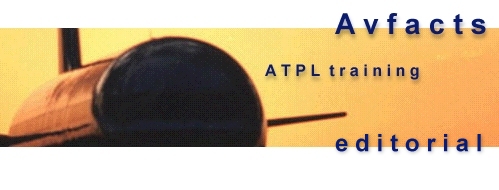




 |
 |
  |
 |
Aircraft Systems Topic 23.
B767 EHSI - Expanded VOR mode
| This mode provides course
tracing information in a 70 degree compass arc.
Orientation Like the FULL VOR mode, it is oriented magnetic HEADING UP. Weather radar returns CAN be displayed in Expanded VOR mode, but cannot be in “Full VOR” mode. Aircraft Symbol Unlike the conventional VOR, the aircraft symbol is shown at the bottom of the screen as a white triangle. The aircraft’s exact position is at the tip of this triangle. VOR selection/distance The VOR receiver that is feeding tracking information to the screen is displayed in green at the bottom left-hand corner of the screen, whilst the distance to that station is in the upper left corner. In this case the left VOR navigation radio is providing info to this display screen. CDI bar/aircraft orientation If the CDI bar is to the left of the aircraft, the desired course is to the left, and vice versa. Turn toward the needle to intercept track.
Heading bug Current is displayed at the 263M compass arc position. Track made good (TMG) When related to the current heading, this shows the degrees of drift occurring. In this case eleven degrees left drift. Track made good (TMG) is 252M/heading 263M. This is logical as the wind arrow shows a wind from the right, being about 340M at 20 knots. Course selector arrow The present VOR course selection is 282M, and the aircraft is slightly right of that course but closing on it, as witnessed by the “TMG” showing TMG of 252M. The calibration of the instrument in VOR mode is 2 degrees per dot. This calibration is automatically loaded when a VOR frequency is tuned. If an ILS frequency was tuned, the calibration would be automatically set at half a degree per dot. With this combination of wind from the right, aircraft close to the station, and an effective cut angle of 30 degrees, the aircraft would soon need to be turning right so as not to miss capturing the selected course. TO/FROM flag Just ahead and to the right of the CDI scale, a TO message is showing. The aircraft is flying TOward the VOR station. On capturing the VOR course of 282M, the aircraft would be tracking inbound on the 102 radial (ie: 282 - 180). The TO/FROM flag is NOT shown when an ILS is tuned. When the aircraft passes overhead the station, the TO flag will change to FROM. The aircraft would then be tracking away FROM the station on the 282 radial. CDI scale This appears at 90 degrees to the selected course on a HSI, not horizontally as is the case in the basic VOR instrument. Weather radar returns Unlike the Full VOR mode, expanded mode allows depiction of any nearby weather. This way the pilot’s can directly relate their course to any adverse weather, and take evasive action. Selected range In this case 20 nm range is selected. The 10 nm position is in mid-screen. Changing screen display range, automatically changes weather radar scale in unison. This mini-editorial is an abbreviated sample from the book “Flying Glass”, and from the soon to be released online ATPL “Aerodynamics and Aircraft Systems” course. Knowledge of EHSI modes form part of the Australian Civil Aviation Safety Authority (CASA) ICAO ATPL syllabus. For more information go to www.aviationshop.com.au/avfacts/atp and www.aviationshop.com.au/avfacts/Study_texts.htm and www.aviationshop.com.au/avfacts/avfacts/atp/default.htm This is one of a series on the B767 EFIS displays - check the editorial index for the others. Best wishes Rob Avery ATPL Instructor  Marty says ... "Goodbye to GA". |
